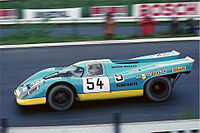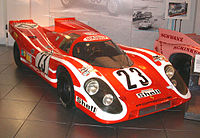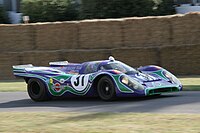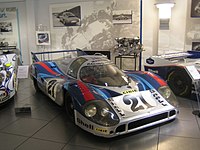Porsche 917
 |
Porsche 917 40th Anniversary
Eleven 917s pull away at Goodwood Festival of Speed 2009
|
The Porsche 917 is a racecar that gave Porsche its first overall wins at the 24 Hours of Le Mansin 1970 and 1971. Powered by the Type 912 flat-12 engine of 4.5, 4.9, or 5 litres, the 917/30 variant was capable of a 0-62 mph (100 km/h) time of 2.3 seconds, 0–124 mph (200 km/h) in 5.3 seconds, and a top speed of over 240 mph (390 km/h).
There are 6 variants of the 917. The original version had a long tail (917LH), but had considerable handling problems at high speed. The Gulf team had then experimented with a shorter tail, and solved the handling problems at the expense of some top speed. Porsche adopted these changes into the 917K. These versions produced around 620 bhp. There is also the "Pink Pig" version, modified 917K with the 908 rear spoilers and the Turbocharged spyder 917/10 and 917/30. In the 1973 Can-Am series, the turbocharged version Porsche 917/30 developed over 1,100 bhp (820 kW), and as much as 1,580 bhp (1,180 kW) in qualifying tune.
The 917 is one of the most iconic sports racing cars of all time, largely for its high speeds and high power outputs, and was made into a movie star by Steve McQueen in his 1971 film Le Mans.
2009 marked the 40th anniversary of the 917, and Porsche held a special birthday celebration at the Goodwood Festival of Speed (3–5 July).
The birth of the 917
In an effort to reduce the speeds generated at Le Mans and other fast circuits of the day by the unlimited capacity Group 6 prototypes (such as the 7-litre Ford GT40 Mk.IV and 4-litre V12 Ferrari P) the Commission Sportive Internationale (then the independent competition arm of theFIA) announced that the International Championship of Makes would be run for 3-litre Group 6 prototypes for four years from 1968 through 1971. This capacity reduction would also serve to entice manufacturers who were already building 3-litre Formula One engines into endurance racing.
Well aware that few manufacturers were ready to take up the challenge immediately, the CSI also allowed the participation of 5-litre Group 4 Sports Cars, of which a minimum of 50 units had to be manufactured. This targeted existing cars like the aging Ford GT40 Mk.I and the newer Lola T70 coupe.
In April 1968, facing few entrants in races, the CSI announced that the minimal production figure to compete in the Sport category of the International Championship of Makes (later the World Sportscar Championship) would be reduced from 50 to 25, starting in 1969 through the planned end of the rules in 1971. With Ferrari absent in 1968, mainly Porsche 908 and Ford P68 were entered there, with the Ford being a total failure. As a result, old 2.2-litre Porsche 907 often won that category, with John Wyer's 4.7-litre Ford GT40 Mk.I taking wins at faster tracks.
Starting in July 1968, Porsche made a surprising and very expensive effort to take advantage of this rule. As they were rebuilding race cars with new chassis every race or two anyway, selling the used cars to customers, they decided to conceive, design and build 25 versions of a whole new car with 4.5-litre for the Sport category with one underlying goal: to win its first overall victory in the 24 Hours of Le Mans on May 14, 1970. In only ten months the Porsche 917 was developed, based on the Porsche 908.
When Porsche was first visited by the CSI inspectors only three cars were completed, while 18 were being assembled and seven additional sets of parts were present. Porsche argued that if they assembled the cars they would then have to take them apart again to prepare the cars for racing. The inspectors refused the homologation and asked to see 25 assembled and working cars.
On March 12, 1969, a 917 was displayed at the Geneva Motor Show, painted white with a green nose and a black #917. Brief literature on the car detailed a cash price of DM 140,000, approximately £16,000 at period exchange rates - or the price of about ten Porsche 911s. This price did not cover the costs of development.
On April 20 Ferdinand Piëch displayed 25 917s parked in front of the Porsche factory to the CSI inspectors. Piëch even offered the opportunity to drive any of the cars, which was declined.
Construction
The car was built around a very light spaceframe chassis (42 kg (93 lb)) which was permanently pressurised with gas to detect cracks in the welded structure. Power came from a new 4.5-litre air-cooled engine designed by Hans Mezger. The 'Type 912' engine featured a 180° flat-12 cylinder layout, twin overhead camshafts driven from centrally mounted gears and twin spark plugs fed from two distributors. The large horizontally mounted cooling fan was also driven from centrally mounted gears. The longitudinally mounted gearbox was designed to take a set of four or five gears.
To keep the car compact despite the large engine, the driving position was so far forward that the feet of the driver were beyond the front wheel axle.
The car had remarkable technology: Porsche’s first 12-cylinder engine, and many components made of titanium, magnesium and exotic alloys that had been developed for lightweight "Bergspider" hill climb racers. Other methods of weight reduction were rather simple, such as making the gear shift knob out of Balsa wood, some methods were not simple, such as using the tubular frame itself, as oil piping to the front oil cooler.
Racing history
1969
In testing, it soon appeared that the Porsche 917 did not work well on the race track. Brian Redman recalls that "it was incredibly unstable, using all the road at speed." Many thought that the 4.5-litre engine was too much for the frame. The suspension and the stability of the frame were suspected, but modifications did not improve the problem. It was finally determined that the "long tail" body was generating significant lift on the straights, as the 917 was 30 km/h (19 mph) faster than anything previously built for Le Mans. As with former underpowered Porsches, the 917 aerodynamics had been optimized for low drag in order to do well on the fast straights of Le Mans, Spa, Monza and elsewhere. The significance of downforce for racing was not yet fully realized even though Can-Am and F1 cars were using wings by that time.
Before its competition debut on 11 May 1969 in the 1000km Spa, the weather conditions prevented further improvements in tests. Jo Siffert/Redman managed to clock an unofficial lap time of 3:41.9 which would have beaten the pole of 3:42.5 set by a Lola, but they chose to use the 908LH long tail with which they won the race and set the fastest lap at 3:37.1. Gerhard Mitter/Udo Schütz actually started the race from 8th, but their already ailing engine failed after one lap.
Three weeks later for the 1000km Nürburgring, all works drivers preferred the 908 over the 917 which was, despite some modifications, not suited for the twisty track. As it was necessary to promote the car in order to sell the surplus ones, Porsche asked BMW for the services of their factory driversHubert Hahne and Dieter Quester. They practised, but Munich declined permission to have them race, so Englishman David Piper and Australian Frank Gardner were hired on short terms. They drove the 917 to an eighth place finish behind a Ford and an Alfa, while the factory's armada of six 908/02 spyders scored a 1-2-3-4-5 win after the only serious competition, a sole Ferrari 312P, failed.
At the 1969 24 Hours of Le Mans, the 917s were quickest in practice. Soon after the start the poor handling of the 917 and the inexperience of one of the drivers resulted in drama: British gentleman-driver John Woolfe crashed his Porsche 917 at Maison Blanche on lap 1, dying as a result. Woolfe was the first privateer to race a 917. The works 917s led the race for hours, but did not make it through the night. At the end, Hans Herrmann's 908 remained as the only Porsche that could challenge for the win, but Jacky Ickx's more powerful Ford won once again, by a mere 120 metres (390 ft).
During June 1969, Enzo Ferrari had sold half of his stock to FIAT, and used some of that money to build 25 cars powered by a 5-litre V12 in order to compete with the Porsche 917: the Ferrari 512 would be introduced for the 1970 season.
At that time, the 917 already had several races under its belt, yet no success. The first win came in the last race of the championship season, the 1000 km Zeltweg. Jo Siffert and Kurt Ahrens succeeded in the privately entered Porsche 917 of German Freiherr von Wendt. At that time, the factory had started to focus on development, leaving the time-consuming trips to races to customer teams.
1970
Disappointed by the poor results of the 917 in 1969, and facing new competition, Porsche concluded an agreement with John Wyer and his JWA Gulf Team, which became the official Porsche team, and also the official development partner. During tests at Zeltweg, where the car had won its only race at that time, Wyer's chief engineer John Horsman noticed that the bodywork had a pattern of dead gnats dashed against it, revealing the airflow. The tail was clean—the presence of no dead gnats indicated that the air was not flowing over the tail. A modification to the tail was cobbled-up on the spot in the pits with aluminium sheets taped together. This new short tail gave the 917 much needed stability from downforce. The plastic engine intake cover had already been removed. The new version was called 917K (Kurzheck).
In addition to the 917, the lightweight and compact Porsche 908/3 were developed for the slow and twisty tracks of Nürburgring and Targa Florio, providing wins while the factory-backed 917 remained in the garages. The 908/3 was built to the FIA's 3-litre Group 6 Prototype regulations whereas the 917 was now officially a Group 5 Sports Car following another FIA review of its racing classes, applicable from 1970.
Wyer was surprised to discover that another team was carefully preparing for the 1970 24 Hours of Le Mans with close support from Porsche. As in 1969, the Porsche Salzburg team was a de facto second works team under control of members of the Porsche family. The Martini Racing team also gained some support from Porsche AG; obviously Porsche made efforts to win the race by supporting more than one team.
Also, a new low drag version of the 917 was developed for Le Mans with support from the external consultant Robert Choulet. The 917LH (Langheck) featured a spectacular new "Long Tail" body including partially covered rear wheel arches which had very low drag, yet better stability than the 1969 version. A few 4.9-litre engines, introduced at 1000km Monza, were available for some cars, but these proved to put too much strain on the gearboxes.
The favorite team to win, Gulf-backed John Wyer Automotive, lined up three 917Ks, two with the 4.9-litre engine and one with the 4.5-litre unit.
Two 917 LH were entered in Le Mans, one in white and red trim by Porsche Salzburg. Driven by Vic Elford and Kurt Ahrens, the pole sitter's 4.9-litre engine failed after 225 laps. Both drivers had also been entered on the team's other car, a red and white 917 K with the standard 4.5-litre engine, qualified by Hans Herrmann and Richard Attwood on rather low 15th spot, but they did not drive after their own car failed.
The other LH was entered by Martini Racing, qualified by Willy Kauhsen and Gérard Larrousse on 12th position. The spectacular livery of this car was an elaborate whirls and swoops of light green on a dark blue background. The car with the regular engine gained the nickname of the Hippie Car or thePsychedelic Porsche from the team and media.
Early in the race, most of the works Ferrari 512 entrants eliminated each other in a shunt. The two Porsche factory teams, Gulf-Wyer and Porsche Salzburg, continued to battle each other, but all Wyer cars were out after 12 hours. At the end it was the red and white #23 917K of Porsche Salzburg, with the standard 4.5-litre engine, carefully driven by Stuttgart's own Hans Herrmann and Englishman Richard Attwood through the pouring rain, that finally scored the first overall win at Le Mans, in a wet race that saw only 7 ranked finishers. Martini's blue 917LH with a green "psychedelic Hippie" design came in 2nd. Both cars were later paraded across Stuttgart. To complete Porsche's triumph, a 908 came third, a 914 sixth, and a 911S seventh, beaten only by two Ferrari 512.
Towards the end of the 1970 season, Ferrari entered some races with a new version of the 512, the 512M (Modificata). The 512M had a new bodywork built on the same aerodynamic doctrine as the Porsche 917K. At the end of 1970 the 512M was faster than the 917s.
During the 1970 season the FIA announced that Group 5 Sports Cars would be limited to a 3-litre engine capacity maximum for the newly renamed World Championship of Makes in 1972, so the big 917s and 512s would have to retire from the championship at the end 1971. Surprisingly, Ferrari decided to give up any official effort with the 512 in order to prepare for the 1972 season. A new prototype, the 312 PB, was presented and entered by the factory in several races. But many 512s were still raced by private teams, most of them converted to M specification.
Having still some of their 25 cars remaining unsold, Ferrari offered them as a bargain for customers at the end of 1970 - a consolation that had hardly been imaginable less than two years previously, when a 917 was offered for 140.000 DM. The original series of 25 flat-12 could not satisfy demand, and over 50 chassis were built in total. Porsche, an underdog for 20 years, had turned itself into the new superpower of sports car racing with the 917.
1971
The domination of Gulf-Wyer and Martini Porsches in 1971 was overwhelming. The only potential challenger to the 917 appeared early in the season: Roger Penske had bought a used 512S chassis that was totally dismantled and rebuilt beyond M specification. The car was specially tuned for long races, receiving many unique features among which were a large rear wing and an aviation-inspired quick refueling system. The engine was tuned by Can-Am V8 specialist Traco and able to deliver more than 600 hp (450 kW). Penske's initiative was not backed by Ferrari works. This 512M, painted in a blue and yellow livery, was sponsored by Sunoco and the Philadelphia Ferrari dealer Kirk F. White. Driven by Penske's lead driver Mark Donohue, it made the pole position for the 24 Hours of Daytona and finished second despite an accident that required almost an hour in the pits. For the 12 Hours of Sebring the "Sunoco" made the pole but finished the race at the sixth position after making contact with Pedro Rodríguez's 917. Despite being fastest on track on a few occasions, the 512M was not a serious contender.
The presence of the 512M "Sunoco", as well as the Alfa Romeo T33/3 which won Brands Hatch, theTarga Florio and Watkins Glen, forced Porsche to pursue their efforts in research and development: tails of the 917K and the 908/3 were modified with vertical fins, and the 917 LH aerodynamics received further improvements. New chassis made of magnesium were developed, even though this material could burn vigorously in the instance of a fire.
A heavily modified car, the 917/20, was built as test-bed for future Can-Am parts and aerodynamic "low-drag" concepts. The 917/20 which had won the test race at Le Mans was painted in pink for the 24 hours race, with names of cuts of meat written in German across it in a similar fashion to a butcher's carcass diagram, earning it the nickname "Der Truffeljäger von Zuffenhausen" (The Truffelhunter of Zuffenhausen) or just plain "Pink Pig".
While testing the 917K for Le Mans, Porsche engineer Norbert Singer asked driver Derek Bell what revs he was pulling the engine on the Mulsanne Straight. He told him 8100 rpm, and Singer said that was good, because the engine would blow up at 8200 rpm. Bell recorded the fastest speed ever on the Mulsanne Straight: 246 mph (394 km/h). And at Le Mans, once again it was not the new machinery that won. The white #22 Martini-entered 917K (chassis number 053) of Helmut Marko and Gijs van Lennep, equipped with a magnesium frame, set an overall distance record that stood until the 2010 win by the Audi R15 TDI of Romain Dumas, Mike Rockenfeller and Timo Bernhard when they set a distance record of 5,335.313 km (3,315.210 mi) at an average speed of 220.2 km/h (137.6 mph).This porsche still holds the fastest lap at the Le Mans racing circuit to this day
1972–1973 Can-Am
As the new rules for the 3-litre prototypes were not favourable to their existing low-weight, low-power Porsche 908, Porsche decided against developing a new high power engine that could keep up with the F1 designs of the competition's - at least in naturally aspirated form. In 1976 they would return to sport-prototype racing with the turbocharged Porsche 936 racecars after the engines were tested in Porsche 911 versions.
After their successes with the 917 mainly in Europe, Porsche instead decided to focus on the North American markets and the Can-Am Challenge. For that series, larger and more powerful engines were needed. A 16-cylinder with about 750 hp (560 kW) was tested, but a turbocharged 12-cylinder had initially the same power, with more to come was used. The 917 chassis also had to be lengthened to accept the longer 16-cylinder engine, and drivers complained that this longer chassis did not handle as well.
The turbocharged 850 hp (630 kW) 917/10 entered by Penske Racing won the 1972 series with George Follmer, after a testing accident sidelined primary driver Mark Donohue. This broke the five-year stranglehold McLaren had on the series. The further evolution of the 917, the 917/30 with revised aerodynamics, a longer wheelbase and an even stronger 5.4-litre engine with up to 1,580 horsepower (1,180 kW) won the 1973 edition winning all races but one with Mark Donohue driving. Most of the opposition was made of private 917/10 as McLaren, unable to compete against the 917 turbos, had already left the series to concentrate on the Indy 500 and F1.
The 917's domination, the oil crisis, and fiery tragedies like Roger Williamson's in Zandvoort pushed the SCCA to introduce a 3 miles per US gallon maximum fuel consumption rule for 1974. Due to this change, the Penske 917/30 competed in only one race in 1974, and some customers retrofitted their 917/10 with naturally aspirated engines.
The 917/30 was the most powerful sports car racer ever built and raced. The 5.374-litre 12 cylinder (90.0 x 70.4 mm) twin-turbocharged engine could produce 1,580 bhp (1,180 kW) in qualifying tune, with twin turbochargers run up to full boost, 39 psi (2.7 bar), though it usually raced with around 1,100 bhp (820 kW) at 7,800 rpm to preserve the engine. Weighing 1,800 lb (820 kg), giving it a power to weight of 1967.36 bhp/tonne in qualifying tune and 1369.68 bhp/tonne in race tune. The 917/30 dominated the Can-Am series during the 1973 season. The 917/30 could go from 0-62 mph (100 km/h) in 1.9 seconds, 0-100 mph (160 km/h) in 3.9 seconds, 0-200 mph (320 km/h) in 10.9 seconds, and on to a top speed of more than 260 mph (420 km/h). The high-level of performance and attendant fuel consumption of the engines, and ever increasing risk, has led to the 917/30 sometimes being cited as the car that killed Can-Am racing.
1981
In 1981, it appeared that new Le Mans regulations would allow a 917 to race again. The Kremer Racing team entered a homebuilt updated 917, the 917 K-81.
The car raced at Le Mans qualifying in the top 10 but retired after seven hours after a collision with a back marker led to a loss of oil and withdrawal.
The final chapter though was to be at Brands Hatch where the car ran in the 6 hours at the end of the season. The car was competitive and ran at or near the front, including a spell in the lead until a suspension failure led to retirement.
Other uses
On 9 August 1975, Porsche and Penske would give the Can-Am car its final send off in style, when they took their 917/30 to Talladega to break the FIA speed record on a closed circuit. With Mark Donohue driving, the average speed reached was 221.160 mph (355.923 km/h).As well as being the last official outing for the 917, it was the last major accomplishment for Donohue before his fatal accident in practice for the Austrian Grand Prix a week later. The record would stand until 1980.
Several 917 coupés as well as 917/10s (powered by turbos or NA engines) were run in Europe's Interserie until the mid-1970s.
Many 917 leftover parts, especially chassis, suspension and brake components, would be used to build the Porsche 936 in 1976.
Despite the car's impracticality, at least two 917s were road-registered:
Count Rossi of the Martini company, bought chassis 030 from Porsche. He raced it once under the Martini Racing Team Flag at the Zeltweg 1000 km World Championship race on 27 June 1971. After the race, it was returned to the factory, where it was modified with basic road equipment (exterior mirrors, turn signals, exhaust system and comfort modifications) and painted silver. None of the European authorities would certify the car for road use and Rossi obtained the Alabama plate 61-27737 to circumvent the problems.
The second, for Joachim Grossmann, was painted white and given the German registration CW-K 917. The Danish car magazine Bilen in a 1977 article details how Grossmann bought the frame and other components of the original Chassis 021 which had crashed badly at Le Mans in 1970 for 20,000 DM, rebuilt it and then modified it (examples: turn signals, hand brake, Safety glass windows and some modifications to the exhaust system) to satisfy German safety inspectors leading to the registration. Grossmann's car is not officially Chassis 021 because other parts from the 1970 wreck at Le Mans were mated to spare frame components and retained the Chassis 021 designation.
Recently, high end replicas that use the flat-6 from the 911 have become available. One is built in Australia by Kraftwerkz, another in the US by Race-Car Replicas.
In addition, a grass roots "replica," the Laser 917,. which is essentially a rebodied VW Beetle, was featured in the film Herbie Goes to Monte Carlo.
The Gulf Oil liveried 917 Kurzhecks are also prominently featured in the Steve McQueen film Le Mans competing against Ferrari's 512 Coda Lunga.
In 1970, Hot Wheels released a Porsche 917 with some different designs.












![Validate my RSS feed [Valid RSS]](valid-rss-rogers.png)















































































ไม่มีความคิดเห็น:
แสดงความคิดเห็น